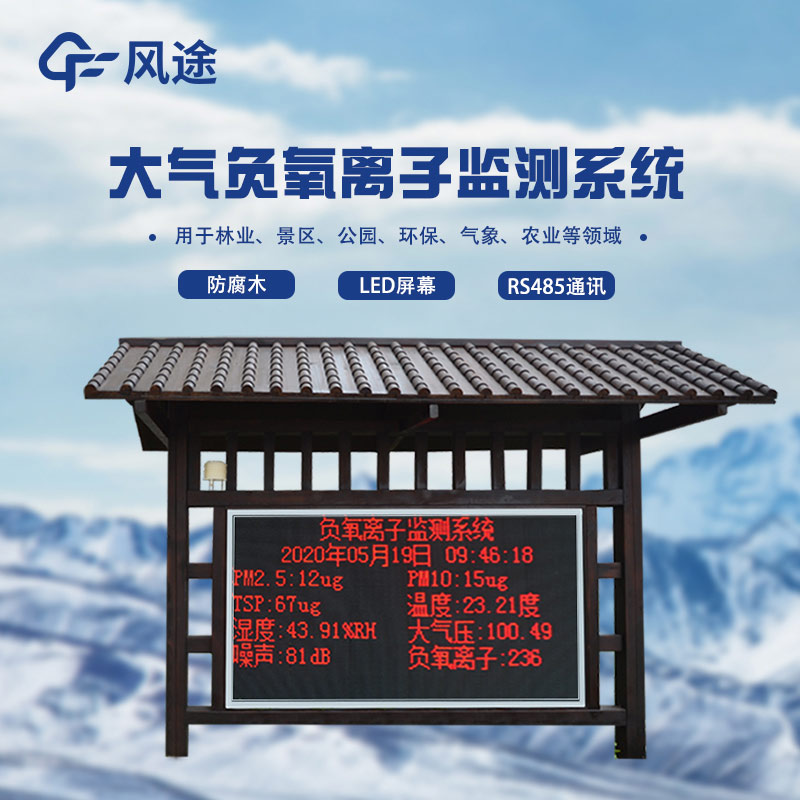Tianqiong Sensor IOT Technology Co., Ltd
Sales Manager:Ms. Emily Wang
Cel,Whatsapp,Wechat:+86 15898932201
Email:info@fengtutec.com
Add:No. 155 Optoelectronic Industry Accelerator, Gaoxin District, Weifang, Shandong, China

Sales Manager:Ms. Emily Wang
Cel,Whatsapp,Wechat:+86 15898932201
Email:info@fengtutec.com
Add:No. 155 Optoelectronic Industry Accelerator, Gaoxin District, Weifang, Shandong, China
time:2025-04-28 10:01:33 source:Weather Station viewed:196 time
In today's society, people are paying increasing attention to air quality. As an important component of the air, the measurement of negative oxygen ions is of great significance in many aspects. Firstly, negative oxygen ions can effectively purify the air by combining with particulate matter, bacteria, and other substances in the air, causing them to settle, improving air quality, and reducing the risk of respiratory diseases. Secondly, they have a positive impact on human health. They can relieve fatigue, enhance immunity, improve sleep, and so on. The concentration of negative oxygen ions is also a key indicator for measuring the quality of the ecological environment. It can reflect the ecological status and natural purification ability of a region, which is of great significance for ecological environment assessment and protection.
In tourist attractions, a high concentration of negative oxygen ions is a major highlight that attracts tourists. It can showcase high-quality air resources to tourists and enhance the competitiveness of the scenic area. Urban parks and green spaces are places where residents go for leisure. Measuring the concentration of negative oxygen ions can help understand the contribution of the urban ecosystem to the health of residents, and assist in the planning and management of parks and green spaces. In ecological environment research areas such as nature reserves and ecological experimental areas, measuring the concentration of negative oxygen ions can help grasp the dynamic changes and stability of the ecological environment, providing data support for ecological research. In densely populated indoor places such as offices, schools, hospitals, and shopping malls, measuring the concentration of negative oxygen ions can evaluate the freshness of indoor air, provide a reference for taking air purification measures, and ensure people's health and work efficiency.
The Negative oxygen ion monitoring station is composed of sensors, a data collection and processing unit, a display screen, and a communication module. It can automatically collect, analyze, and display negative oxygen ion data, and at the same time transmit the data to the monitoring platform or management terminal.
Its advantages are as follows:
Firstly, real-time monitoring and display. It can continuously monitor the concentration of negative oxygen ions 24 hours a day, and present the data accurately and in a timely manner through the display screen, allowing people to keep abreast of the air quality situation at any time and providing a reference for daily life and travel.
Secondly, high precision and strong stability. By adopting high-precision sensor technology and data processing algorithms, it can accurately measure the concentration of negative oxygen ions, ensuring the accuracy and reliability of the data. Moreover, it can operate stably for a long time under different environmental conditions, reducing the risk of data errors and losses, and providing strong data support for scientific research and environmental management.
Thirdly, multi-functional integration and data sharing. In addition to monitoring negative oxygen ions, it can also measure environmental parameters such as temperature, humidity, air pressure, PM2.5, and PM10, forming a comprehensive data chain. Through wired or wireless communication methods, the data is transmitted to the cloud platform or monitoring center in real time, facilitating remote access and sharing. It enables comprehensive analysis and evaluation of environmental quality, providing a comprehensive basis for formulating environmental protection measures and policies.

As a device widely used in fields such as water conservancy monitoring, environmental governance, and engineering construction, a flow meter can monitor water flow velocity data in real time with high accuracy, providing a scientific basis for decision-making. Currently, mainstream flow meters on th...
The next-generation standard Farmland Weather Station deeply integrates IoT (Internet of Things) technology and big data analysis. As a crucial tool in modern agricultural production monitoring, it provides farmers with full-process production data support from sowing to harvest.The station is speci...
Rainfall is one of the important water cycle links in nature. Accurate measurement of rainfall is of great significance for agricultural irrigation, urban flood control, water resource management, meteorological research and other fields, as it provides key data support for decision-making in these...
The Ultrasonic Wind Speed Direction Sensor achieves measurement based on the characteristics of ultrasonic waves propagating in the air. It accurately calculates the wind speed and direction by measuring the time difference of ultrasonic waves propagating in different directions. This non-mechanical...